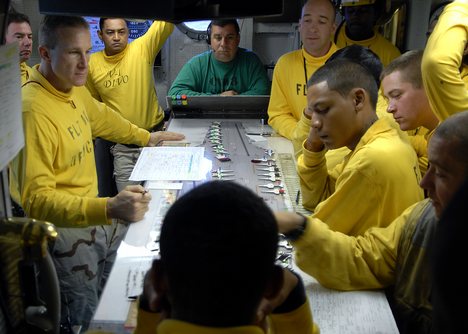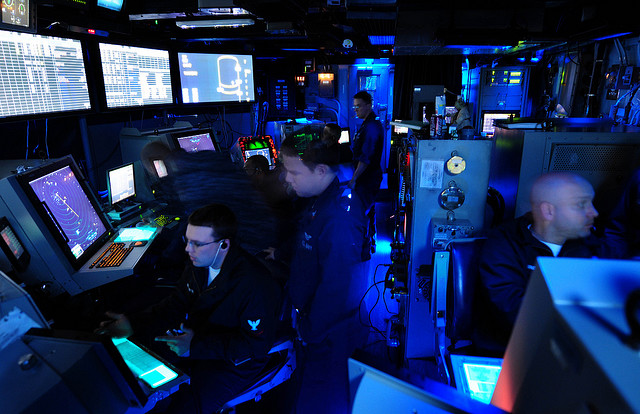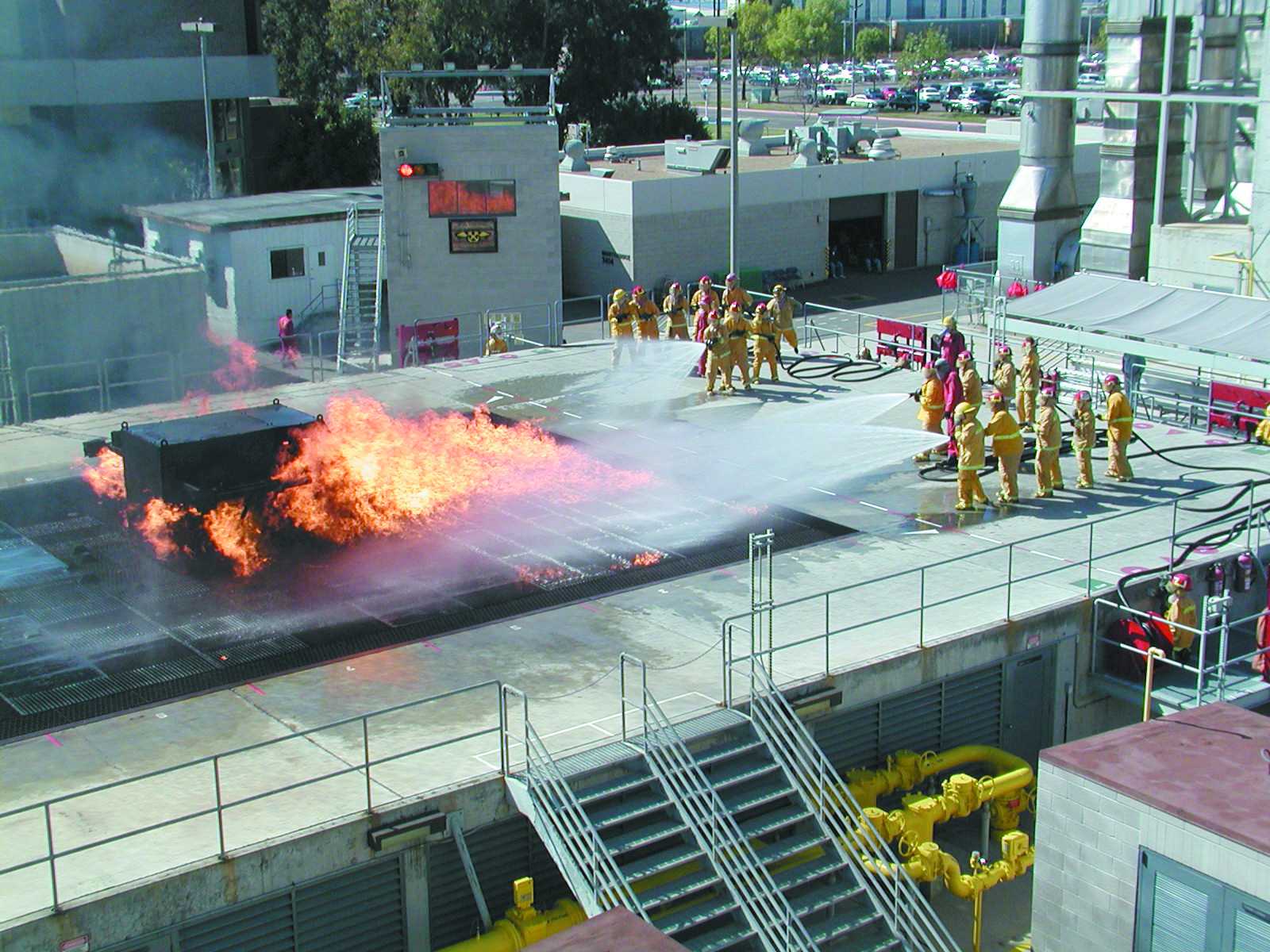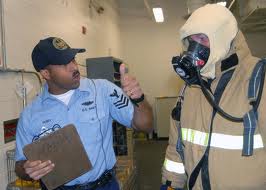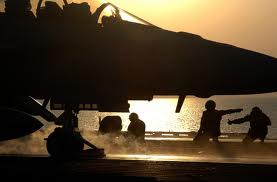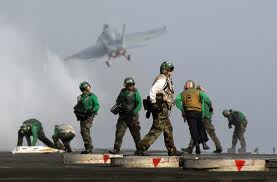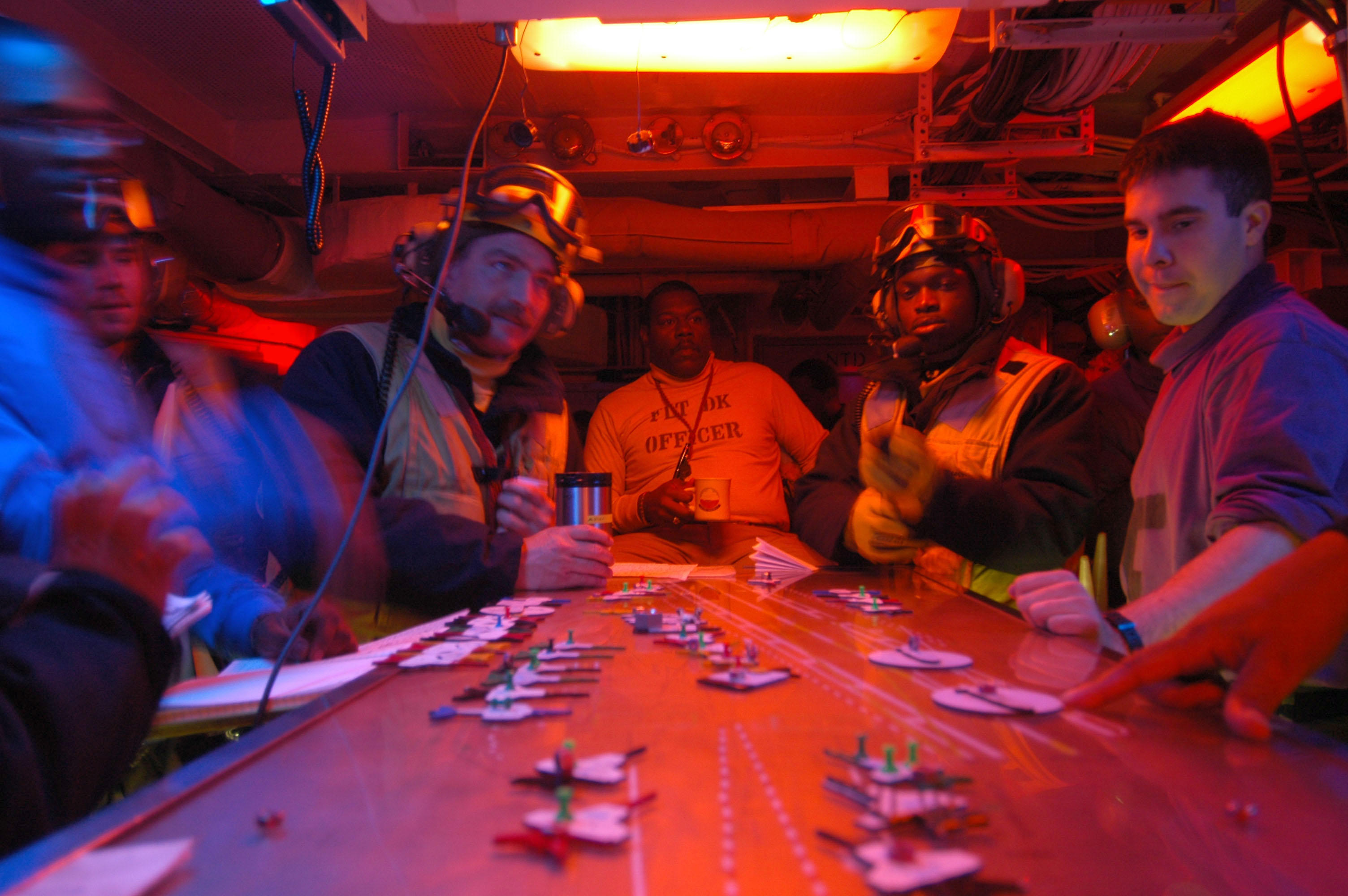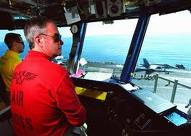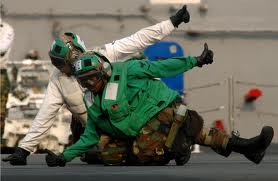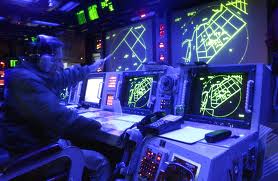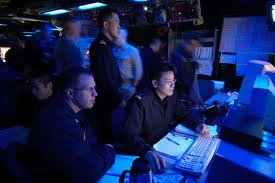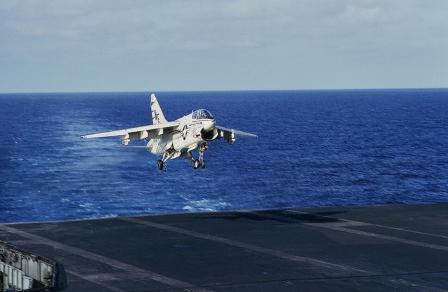Mar.04.2011
2:51 pm
by Ed Beakley
Part 2 of Schoolboy’s Bad Night: Continuation of the Self-Designing High Reliability Organization Discussion
Boundary Condition #2 (3)
A work in progress: With this post we conclude the second round of discussion on our 2011 boundary conditions. Before reading Part 2, a few thoughts:
Of no surprise should be the issue of training as a key to operating successfully in unstable or high stress, high impact situations. But what is emerging is the degree to which it is not just training to task no matter how detailed or how continuous, but apparently training combined with learning so as to teach recognition and perception skills i.e., how to recognize the edges of the envelop almost before those edges are actually defined. Out of the Boyd discussion – smart Observation and then Orientation.
Recall Dr. Chet Richards question from the end of the “Synthesis” discussion closing the Washington article: ”What kind of organizations operate at rapid OODA loop tempo? Organizations whose leaders have, over time, imbued certain qualities into the fiber of their very being, with these four qualities:
- Superb competence, leading to a Zen-like state of intuitive understanding. Ability to sense when the time is ripe for action.
- Common outlook towards problems. Superb competence and intuitive understanding at the organizational level.
- Concept that answers the question, “What do I do next?” in ambiguous situations
- Understood and agreed to accountability
Now reflect on some extracts from the comments:
- In order to prepare responders for this it takes training that involves blending cognitive abilities with the physical action taking, working all stages of the Boyd Cycle
- The relative speed of accurate perception (orientation) and decision to action is key. Achieving success in this dynamic relies on training/education, exercising, red teaming (or adaptive red teaming/alternative analysis during preparatory phases — pre-incident —and actual response — trans-/post-incident).
- One of the deficiencies in current incident command training is how to “orient” yourself to the situation. Responding to an unfolding event is totally different than commanding a planned event.
- Problems in recognition: First, some responders develop their SA once and then do not re-observe until things get bad or a sudden change occurs on the incident. Second, Orientation often stays confined to where a responder starts at an incident. Some also freeze their orientation to a specific point in time as they make decisions, usually their first encounter at the scene.
- A main concept in the HRO work is that if you train people, have them understand the true risk of the work they are doing, and keep them stimulated they can both become experts in their areas and be able to recognize when events fall outside of the usual pattern (unconventional crisis). With this recognition they can utilize their training to develop creative response approaches. But it is key that they are able to know with certainty that a crisis is unconventional so that they do not make errors regarding their response.
- Preparedness is motivated by the perception of the threat. That is why car insurance is more expensive for 20 year olds than. 50 year olds. Young men perceive the threat differently, and have less motivation to be prepared, or to avoid thresholds likely to cause problems. Carrier flight deck accidents occur with sufficient regularity to keep perceptions of the threat high. Katrina-type storms don’t.
Consider these points as you continue reading Part 2 of the research work on high reliability organizations. How much then applies to unconventional crisis as defined? Are the narratives of George Washington’s leadership and carrier aviation instructive in that context? Does OODA as an analysis tool lead to learning?
The Extract continues
Self-Design and Self-Replication
Today’s aircraft carrier flight operations are as much a product of their history and continuity of operation as of their design. The complexity of operations aboard a large, modern carrier flying the latest aircraft is so great that no one, on or off the ship, can know the content and sequence of every task needed to make sure the aircraft fly safely, reliably, and on schedule. As with many organizations of similar size and complexity, tasks are broken down internally into smaller and more homogeneous units as well as task-oriented work groups…
In order to keep this network alive and coordinated, it must be kept connected and integrated horizontally (e.g., across squadrons), vertically (from maintenance and fuel up through operations), and across command structures (battle group–ship–air wing). As in all large organizations, the responsible officer or chief petty officer has to know what to do in each case, how to get it done, whom to report to and why, and how to coordinate with all units that he depends upon or that depend upon him. This is complicated in the Navy case by the requirement for many personnel, particularly the more senior officers, to interact on a regular basis with those from several separate organizational hierarchies. Each has several different roles to play depending upon which of the structures is in effect at any given time.
Furthermore, these organizational structures also shift in time to adapt to varying circumstances. The evolution of the separate units (e.g., ship, air wing, command structures) and their integration during workup into a fully coordinated operational team, for example, have few, if any, applicable counterparts in civilian organizations.
There is also no civilian counterpart for the requirement to adapt to rapid shifts in role and authority in response to changing tactical circumstances during deployment.
No armchair designer, even one with extensive carrier service, could sit down and lay out all the relationships and interdependencies, let alone the criticality and time sequence of all the individual tasks. Both tasks and coordination have evolved through the incremental accumulation of experience to the point where there probably is no single person in the Navy who is familiar with them all. …
For a variety of reasons, no two aircraft carriers, even of the same class, are quite alike. ..What is more, even the same formal assignment will vary according to time and place. Carriers differ; missions differ; requirements differ from Atlantic to Pacific, and from fleet to fleet; ships have different histories and traditions, and different equipment; and commanding officers and admirals retain the discretion to run their ships and groups in different ways and to emphasize different aspects. Increased standardization of carriers, aircraft loadings, missions, tasks, and organizational structure would be difficult to obtain, and perhaps not even wise. There is a great deal to learn in the Navy, and much of it is only available on the spot.
Shore-based school training for officers and crew provides only basic instruction. It includes a great deal about what needs to be done and the formal rules for doing it. Yet it only provides generalized guidelines and a standardized framework to smooth the transition to the real job of performing the same tasks on board as part of a complex system. NATOPS and other written guidelines represent the book of historical errors. They provide boundaries to prevent certain actions known to have adverse outcomes, but little guidance as to how to promote optimal ones.
Operations manuals are full of details of specific tasks at the micro level but rarely discuss integration into the whole. There are other written rules and procedures, from training manuals through standard operating procedures (SOPs), that describe and standardize the process of integration. None of them explain how to make the whole system operate smoothly, let alone at the level of performance that we have observed. It is in the real-world environment of workups and deployment, through the continual training and retraining of officers and crew, that the information needed for safe and efficient operation is developed, transmitted, and maintained. Without that continuity, and without sufficient operational time at sea, both effectiveness and safety would suffer.
Moreover, the organization is not stable over time. Every forty months or so there is an almost 100 percent turnover of crew, and all of the officers will have rotated through and gone on to other duty. Yet the ship remains functional at a high level. …
Behavioral and cultural norms, SOPs, and regulations are necessary, but they are far from sufficient to preserve operational structure and the character of the service. Our research team noted three mechanisms that act to maintain and transmit operational factors in the face of rapid turnover.
First, and in some ways most important, is the pool of chief petty officers, many of whom have long service in their specialty and circulate around similar ships in the fleet.
Second, many of the officers and some of the crew will have at some time served on other carriers, albeit in other jobs, and bring to the ship some of the shared experience of the entire force.
Third, the process of continual rotation and replacement, even while on deployment, maintains a continuity that is broken only during a major refit. These mechanisms are realized by an uninterrupted process of on-board training and retraining that makes the ship one huge, continuing school for its officers and men.
The Paradox of High Turnover
“As soon as you learn 90% of your job, it’s time to move on. That’s the Navy way.” Junior officer
Because of the high turnover rate, a U.S. aircraft carrier will begin its workup with a large percentage of new hands in the crew, and with a high proportion of officers new to the ship. The U.S. Navy’s tradition of training generalist officers (which distinguishes it from the other military services) assures that many of them will also be new to their specific jobs. Furthermore, tours of duty are not coordinated with ship sailing schedules; hence, the continual replacement of experienced with “green” personnel, in critical as well as routine jobs, continues even during periods of actual deployment.
Continual rotation creates the potential for confusion and uncertainty, even in relatively standardized military organizations. …
It takes time and effort to turn a collection of men, even men with the common training and common background of a tightly knit peacetime military service, into a smoothly functioning operations and management team. SOPs and other formal rules help, but the organization must learn to function with minimal dependence upon team stability and personal factors…
Yet we credit this practice with contributing greatly to the effectiveness of naval organizations. There are two general reasons for this paradox.
First, the efforts that must be made to ease the resulting strain on the organization seem to have positive effects that go beyond the problem they directly address.
Second, officers must develop authority and command respect from those senior enlisted specialists upon whom they depend and from whom they must learn the specifics of task performance.
The Navy’s training cycle is perforce dictated by the schedule of its ships, not of its personnel. Because of high social costs of long sea-duty tours, the Navy has long had to deal with such continual turnover–it attempts as best it can to mitigate the negative effects. Most important is the institutionalization of continual, cyclic training as part of organizational and individual expectations. This is designed to bring new people “up to speed” with the current phase of the operational cycle, thus stabilizing the environment just before and during deployment; however, this is accomplished at the cost of pushing the turbulence down into individual units. Although the deployment cycle clearly distinguishes periods of “training” from those of “operations,” it is a measure of competence and emphasis, not of procedural substance that applies primarily to the ship as a unit, not its men as individuals.
The result is a relatively open system that exploits the process of training and retraining as a means for socialization and acculturation. At any given moment, all but the most junior of the officers and crew are acting as teacher as well as trainee. …
As a result, the ship appears to us as one gigantic school, not in the sense of rote learning, but in the positive sense of a genuine search for acquisition and improvement of skills. One of the great enemies of high reliability is the usual “civilian” combination of stability, routinization, and lack of challenge and variety that predispose an organization to relax vigilance and sink into a dangerous complacency that can lead to carelessness and error.
The shipboard environment on a carrier is never that stable. Traditional ways of doing things are both accepted and constantly challenged. Young officers rotate in with new ideas and approaches; old chiefs remain aboard to argue for tradition and experience. The resulting dynamic can be the source of some confusion and uncertainty at times, but at its best leads to a constant scrutiny and re-scrutiny of every detail, even for SOPs.
In general, the Navy has managed to change the rapid personnel turnover to an advantage through a number of mechanisms that have evolved by trial and error. SOPs and procedures, for example, are often unusually robust, which in turn contributes another increment to reliability. The continual movement of people rapidly diffuses organizational and technical innovation as well as “lessons learned,” often in the form of “sea stories,” throughout the organization. Technical innovation is eagerly sought where it will clearly increase both reliability and effectiveness, yet resisted when suggested purely for its own sake. …
Authority Overlays
“Here I’m responsible for the lives of my gang. In civilian life, I’m the kind of guy you wouldn’t like to meet on a dark street.– Deck petty officer
Our team noted with some surprise the adaptability and flexibility of what is, after all, a military organization in the day-to-day performance of its tasks. On paper, the ship is formally organized in a steep hierarchy by rank with clear chains of command, and means to enforce authority far beyond those of any civilian organization. We supposed it to be run by the book, with a constant series of formal orders, salutes, and yes-sirs. Often it is, but flight operations are not conducted that way.
Flight operations and planning are usually conducted as if the organization were relatively “flat” and collegial. This contributes greatly to the ability to seek the proper, immediate balance between the drive for safety and reliability and that for combat effectiveness. Events on the flight deck, for example, can happen too quickly to allow for appeals through a chain of command. Even the lowest rating on the deck has not only the authority but the obligation to suspend flight operations immediately, under the proper circumstances, without first clearing it with superiors. Although his judgment may later be reviewed or even criticized, he will not be penalized for being wrong and will often be publicly congratulated if he is right.
Coordinated planning for the next day’s air operations requires a series of involved trade-offs between mission requirements and the demands of training, flight time, maintenance, ordnance, and aircraft handling. It is largely done by a process of ongoing and continuing argument and negotiation among personnel from many units, in person and via phone, which tend to be resolved by direct order only when the rare impasse develops that requires an appeal to higher authority. In each negotiation, most officers play a dual role, resisting excessive demands from others that would compromise the safety or future performance of their units, while maximizing demands on others for operational and logistic support.
This does not mean that formal rank and hierarchy are unimportant. In fact, they are the lubricant that makes the informal processes work. Unlike the situation in most civilian organizations, relative ranking in the hierarchy is largely stable and shaped by regular expectations, formal rules, and procedures. … the shipboard situation tends to promote cooperative behavior, which tends to minimize the negative effects of jealousy and direct competition. .. we rarely observe such strategies as the hoarding of information or deliberate undermining of the ability of others to perform their jobs that characterize so many civilian organizations, particularly in the public sector.
Redundancy
“How does it work? On paper, it can’t, and it don’t. So you try it. After a while, you figure out how to do it right and keep doing it that way. Then we just get out there and train the guys to make it work. The ones that get it we make POs. ‡ The rest just slog through their time.”- Flight deck CPO
Operational redundancy–the ability to provide for the execution of a task if the primary unit fails or falters–is necessary for high-reliability organizations to manage activities that are sufficiently dangerous to cause serious consequences in the event of operational failures. In classic organizational theory, redundancy is provided by some combination of duplication (two units performing the same function) and overlap (two units with functional areas in common). Its enemies are mechanistic management models that seek to eliminate these valuable modes in the name of “efficiency.” For a carrier at sea, several kinds of redundancy are necessary, even for normal peacetime operations, each of which creates its own kinds of stress.
A primary form is technical redundancy involving operations-critical units or components on board–computers, radar antennas, etc. In any fighting ship, as much redundancy is built in as is practicable. This kind of redundancy is traditional and well understood. Another form is supply redundancy. …Here is a clear case of a trade-off between operational and safety reliability that must be made much closer to the edge of the envelope than would be the case for other kinds of organizations. Indeed, for a combat organization, the trade-off point is generally taken as a measure of overall competence.
Most interesting to our research is a third form, decision/management redundancy, which encompasses a number of organizational strategies to ensure that critical decisions are timely and correct. This has two primary aspects: (a) internal cross-checks on decisions, even at the micro level; and, (b) fail-safe redundancy in case one management unit should fail or be put out of operation. It is in this area that the rather unique Navy way of doing things is the most interesting, theoretically as well as practically.
As an example of (a), almost everyone involved in bringing the aircraft [in for a landing] on board is part of a constant loop of conversation and verification taking place over several different channels at once. …. This constant flow of information about each safety-critical activity, monitored by many different listeners on several different communications nets, is designed specifically to assure that any critical element that is out of place will be discovered or noticed by someone before it causes problems….
Fail-safe redundancy, (b), is achieved in a number of ways. Duplication and overlap, the most familiar modes of error detection, are used to some extent–for example, in checking mission weapons loading. Nevertheless, there are limits to how they can be provided. Space and billets are tight at sea, even on a nuclear-powered carrier, and unlike land-based organizations, the seagoing Navy cannot simply add extra departments and ratings. Shipboard constraints and demands require a considerable amount of redundancy at relatively small cost in personnel. In addition to the classic “enlightened waste” approach of tolerance for considerable duplication and overlap, other, more efficient strategies that use existing units with other primary tasks as backups are required, such as “stressing the survivor” and mobilizing organizational “reserves.”
Stressing-the-survivor strategies require that each of the units normally operate below capacity so that if one fails or is unavailable, its tasks can be shifted to others without severely overloading them. Redundancy on the bridge is a good example. 34 Mobilizing reserves entails the creation of a “shadow” unit able to pick up the task if necessary. … Most of the officers and a fair proportion of senior enlisted men are familiar with several tasks other than the ones they normally perform and could execute them in an emergency.
The Combat Direction Center (CDC, or just “Combat”), for example, is the center for fighting the ship. Crucial decisions are thereby placed nominally in the hands of relatively junior officers in a single, comparatively vulnerable location. In this case we have noted several of the mechanisms described above. There is a considerable amount of senior oversight, even in calm periods. A number of people are “just watching,” keeping track of each other’s jobs or monitoring the situation from other locations. There is no one place on the ship that duplicates the organizational function of Combat, yet each of the tasks has a backup somewhere–on the carrier or distributed among other elements of the battle group.
In an “ordinary” organization these parameters would likely be characterized in negative terms. Backup systems differ in pattern and structure from primary ones. Those with task responsibility are constantly under the critical eyes of others. Authority and responsibilities are distributed in different patterns and may shift in contingencies. In naval circumstances, where reliability is paramount, these are seen as positive and cooperative, for it is the task that is of primary importance.
Thus, those elements of Navy “culture” that have the greatest potential for creating confusion and uncertainty turn out to be major contributors to organizational reliability and robustness under stress. We believe this to be an example of adaptive organizational evolution to circumstance, for it responds very well to the functional necessities of modern operations.
Some Preliminary Conclusions
“The job of this ship is to shoot the airplanes off the pointy end and catch them back on the blunt end. The rest is detail.”- Carrier commanding officer
Even though our research is far from complete, particularly with regard to comparisons with other organizations, several interesting observations and lessons have already been recorded.
First, the remarkable degree of personal and organizational flexibility we have observed is essential for performing operational tasks that continue to increase in complexity as technology advances. “Ordinary” organizational theory would characterize aircraft carrier operations as confusing and inefficient, especially for an organization with a strong and steep formal management hierarchy (i.e., any “quasi-military” organization). However, the resulting redundancy and flexibility are, in fact, remarkably efficient in terms of making the best use of space-limited personnel.
Second, an effective fighting carrier is not a passive weapon that can be kept on a shelf until it is needed. She is a living unit possessed of dynamic processes of self-replication and self-reconstruction that can only be nurtured by retaining experienced personnel, particularly among the chiefs, and by giving her sufficient operational time at sea. This implies a certain minimum budgetary cost for maintaining a first-line carrier force at the levels of operational capability and safety demanded of the U.S. Navy.
Third, as long-term students of organizations, we are astounded at how little of the existing literature is applicable to the study of ships at sea. Consider, for example, the way in which the several units that make up a battle group (carrier, air wing, supply ships, escorts) are in a continual process of formation and reformation. Imagine any other organization performing effectively when it is periodically separated from and then rejoins the unit that performs its central technical function. More importantly, most of the existing literature was developed for failure-tolerant, civilian organizations with definite and measurable outputs. The complementary body on public organizations assumes not only a tolerance for failure, but at best an ambiguous definition of what measures failure (or for that matter, success).
Also see:
IV. Bad Night for Schoolboy – And Other Stories of the Carrier
1. The Pilot’s Story: Bruce Kallsen VA-115
Filed in 2011 Boundary Conditions,Fly Navy-100 Years | Comments Off
